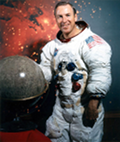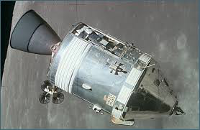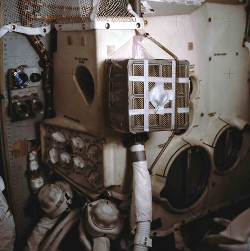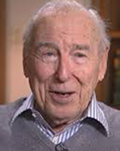Jim Lovell: Former Astronaut, Military Pilot
Jim Lovell is a former Navy pilot and astronaut who is most well-known for commanding two Apollo missions, one of which landed on the Moon. 
He was born in 1928 in Cleveland. His father died when the young boy was 5, and he and his mother lived for awhile in Indiana. They moved to Milwaukee, and Lovell graduated from Juneau High School in 1946. After two years of study at the University of Wisconsin-Madison, he joined the Navy. Four years later, in 1952, he graduated with a bachelor of science degree and entered flight training, at the Pensacola, Fla., Naval Air Station. Also in 1952, he married Marilyn Gerlach; they have four children. He flew night fighters for a time and then completed a test pilot training course at Patuxent River, Md. Two of his classmates were future astronauts Pete Conrad and Wally Schirra. All three applied to join the astronaut squad at NASA in the early days of Project Mercury, which featured one-man space capsules. Only Schirra was accepted. Lovell (and Conrad as well) was accepted in Astronaut Group 2, and both flew on missions during Project Gemini. Lovell was the pilot of Gemini 7, which spent 14 days orbiting Earth and performed the first space rendezvous, with Gemini 6a. He was backup commander of Gemini 9 and commander of Gemini 12. Lovell served as Command Module Pilot of Apollo 8, the first manned mission that orbited the Earth. Because the crew were orbiting the Moon on Christmas Eve, they were inspired to use one of their TV transmissions to read from the Biblical book of Genesis the story of Creation. All three astronauts took turns reading from the Bible, their words traveling through space and to listeners back on Earth.  When it was time to return, Apollo 8 went one last time behind the Moon for a final burn, to power the return flight. Whenever the spacecraft went behind the far side of the Moon, their signal was lost and everyone on Earth held their breath. One of the first things that Lovell said to Mission Control when they had re-established contact was, "Please be informed, there is a Santa Claus." Lovell stayed in the astronaut corps and served as backup commander for Apollo 11, the first crew to walk on the Moon. He was then slated to command the Apollo 14 mission, but NASA swapped the crews of that mission and the one before, Apollo 13, so that Alan Shepard and his crew could get more training time. Launch date for Apollo 13 was April 11, 1970. The launch proceeded without incident and, after a series of burns and maneuvers, the crew were on their way to the Moon. Two days in, on April 13, the crew had just finished a TV broadcast that explained what it was like in the spacecraft and what their mission would entail when they got to the lunar surface when NASA controllers noticed a warning signal on a hydrogen tank in the orbiting craft, which was named Odyssey. Warning signals and lights were not uncommon on Apollo mission; some had been problems that had been overcome, and others had been false alarms. The flipping of a switch for what was supposed to be a routine procedure resulted in an explosion that destroyed one oxygen tank and damaged another. Lovell was the second member of the crew to tell Mission Control, "Houston, we've had a problem." His crewmate Jack Swigert was the first. Lovell reiterated the message in response to a query from Mission Control. 
With the spacecraft venting oxygen, the crew abandoned the main mission objective of walking on the Moon and concentrated on getting home alive. They turned their Lunar Module into a lifeboat, surviving in cramped quarters for four days in near-freezing temperatures and trying to conserve both oxygen and carbon dioxide. Even though they had limited their oxygen supply, they could do nothing about the carbon dioxide that they were venting into the spacecraft cabin just by exhaling. Aquarius, the Lunar Module, had a system to cleanse the air, but it was designed to accommodate two people for two days, not three people for four days. Compounding the problem was the fact that they couldn't "strap on" a system from Odyssey, the Command Service Module, because the two filters were not interchangeable. In one of the space program's more legendary but true examples of genius, scientists on the ground figured out a way for the crew up in space to use the hardware and tools that they had onboard–such as maps and duct tape–to create a workaround; it worked. One of the Mission Control crew working tirelessly to find solutions based on ground-based simulations was Ken Mattingly, who was originally a member of the Apollo 13 crew but had been exposed to rubella, for which he had no immunity, and replaced by Swigert. Lovell and his crew survived the trip home (after first traveling past the Moon in order to use the lunar gravity as a slingshot to compensate for the power that was being conserved), and they breathed a very heavy sigh of relief when they splashed down six days after they had left. Lovell left both the Navy and the space program in 1973 and went to work in the private sector. He had executive positions at three companies and then retired in 1991. 
Lovell was co-author of a 1994 book titled Lost Moon: The Perilous Voyage of Apollo 13. Hollywood film director Ron Howard used the book as the basis for his film Apollo 13, in which Tom Hanks plays Lovell. The film has a scene in which the crew have successfully splashed down and come aboard the ship that has come to greet them, the Iwo Jima. The ship's skipper was Leland Kirkemo, and playing him in the film was Lovell himself. (His wife, Marilyn, also has a cameo in the film, as part of a crowd.) Several organizations have included Lovell on their board of directors. Also occupying his time in retirement has been a series of visits to universities, giving speeches in which he urges students to study science and the space program. Named for him are a science museum, a health care center, and a street in Milwaukee and a crater on the far side of the Moon. |
|
Social Studies for Kids
copyright 2002–2025
David White




